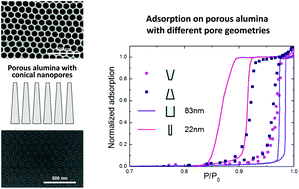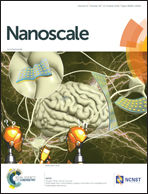Adsorption on alumina nanopores with conical shape†
Abstract
Adsorption on porous solids depends on the morphology of the pores, the cylindrical one being the most studied in the literature. In this work, we present the first experimental investigation of adsorption and evaporation on conical nanopores produced by anodization of aluminium oxide. The pores are about 50 μm long, with the wide ends having a diameter of ∼79 nm and the narrow ones of ∼30 nm. Three different pores configurations are considered: open at both ends, open only at the narrow end and open only at the wide end. Despite the very small value of the conical angle α, estimated to be ∼0.06°, just barely above α = 0° corresponding to a cylindrical pore, the adsorption isotherms look strikingly different from those measured on cylindrical pores of similar size. First of all, the hysteresis loops of the conical pores with two open ends and with open wide ends practically coincide. Furthermore, they are narrower and the adsorption and evaporation branches are broader than those of the cylindrical pores with similar size. Finally, conical pores with open narrow ends exhibit a large hysteresis indicative of pore blocking. To unravel the mechanisms underlying adsorption and evaporation in such conical pores, we also report complementary results obtained using on-lattice grand canonical Monte Carlo simulations.



 Please wait while we load your content...
Please wait while we load your content...